The Dark Analytics Market is estimated to be valued at USD 0.9 billion in 2025 and is projected to reach USD 5.5 billion by 2035, registering a compound annual growth rate (CAGR) of 20.4% over the forecast period.
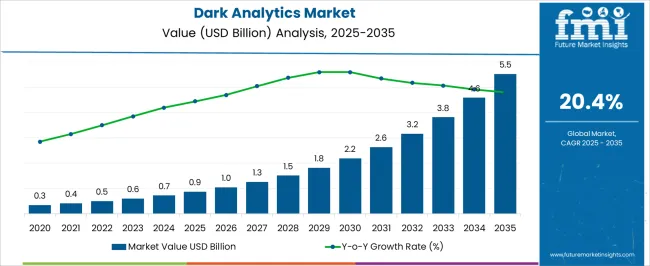
| Metric | Value |
|---|---|
| Dark Analytics Market Estimated Value in (2025 E) | USD 0.9 billion |
| Dark Analytics Market Forecast Value in (2035 F) | USD 5.5 billion |
| Forecast CAGR (2025 to 2035) | 20.4% |
The dark analytics market is experiencing strong momentum as organizations increasingly recognize the untapped potential of unstructured and hidden data. Business publications and technology press releases have underscored that enterprises are generating massive volumes of dark data through emails, call logs, images, videos, and IoT sensors, yet only a fraction is being analyzed effectively.
Advances in artificial intelligence, natural language processing, and machine learning are enabling the conversion of dark data into actionable insights, enhancing decision-making across industries. Corporate investor updates have highlighted rising investments in analytics platforms that integrate structured and unstructured datasets, fueling competitive advantages in customer engagement, risk management, and operational efficiency.
Additionally, compliance with regulatory frameworks has pushed companies to adopt dark analytics solutions for monitoring sensitive data and preventing security breaches. The future trajectory of this market is expected to be shaped by predictive analytics, business-focused dark data applications, and increasing adoption within BFSI, where data-driven risk assessment and fraud prevention remain priorities.
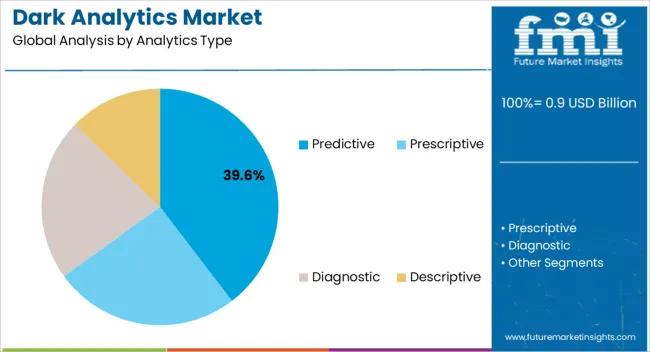
The Predictive analytics segment is projected to contribute 39.60% of the dark analytics market revenue in 2025, establishing itself as the leading analytics type. Growth of this segment has been supported by the demand for forward-looking insights that can anticipate customer behavior, financial risks, and operational inefficiencies.
Predictive models applied to dark data have enabled enterprises to identify hidden trends and forecast future outcomes with greater precision. Industry reports have shown that companies are increasingly leveraging predictive analytics to enhance competitive positioning by reducing uncertainty in strategic planning.
Furthermore, the integration of predictive models with artificial intelligence has allowed organizations to process large volumes of unstructured data rapidly, supporting real-time decision-making. As digital transformation accelerates, predictive analytics is expected to remain at the forefront of dark analytics adoption, driven by its proven ability to convert latent data into strategic foresight.
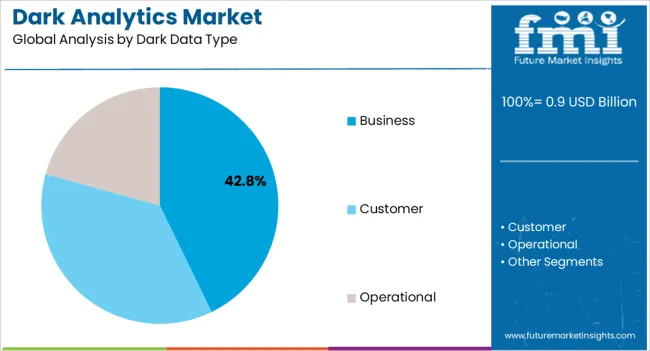
The Business dark data segment is projected to hold 42.80% of the dark analytics market revenue in 2025, making it the largest data type category. This dominance has been attributed to the vast amount of unstructured and underutilized business information generated through customer interactions, internal communications, and enterprise systems.
Organizations have prioritized business dark data analytics to improve decision-making, refine customer engagement strategies, and enhance compliance monitoring. Investor presentations and corporate disclosures have highlighted that analyzing business dark data has led to improvements in workforce productivity and better alignment of resources with organizational goals.
The growing focus on extracting value from call center records, sales logs, and customer service transcripts has further supported this segment’s growth. With enterprises under pressure to remain agile and data-driven, business dark data analytics is expected to continue as the central pillar of dark analytics strategies.
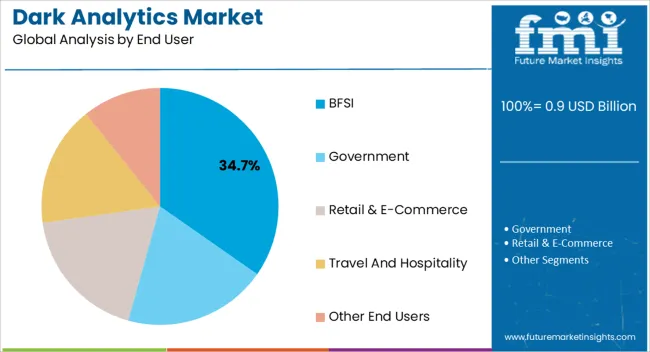
The BFSI segment is projected to account for 34.70% of the dark analytics market revenue in 2025, sustaining its leadership among end users. Growth of this segment has been driven by the sector’s reliance on large volumes of sensitive and unstructured data, including customer records, transaction logs, and regulatory documentation.
Financial institutions have increasingly adopted dark analytics to strengthen fraud detection, enhance risk modeling, and ensure compliance with evolving regulatory frameworks. Industry briefings and financial sector reports have emphasized the role of dark analytics in enabling banks and insurers to detect anomalies in real time, reducing financial crime exposure.
Additionally, predictive analytics applied to BFSI dark data has improved credit risk assessment and customer segmentation strategies. With ongoing digitization of banking services and rising cybersecurity threats, the BFSI segment is expected to remain the leading adopter of dark analytics solutions, reinforcing its share in the market.
Digitization of Businesses & Potential to Optimize Real-time Data Will Act as Prominent Growth Drivers
The major factor that is expected to propel the growth of the Dark Analytics market during the forecast period includes extracting insights for decision making by immediate analysis of real-time information from key business processes such as sales, production, and distribution trends.
Additionally, factors such as gaining insights from and making the most of every data point, efficiency in terms of time, money, and resources in processing unstructured data, and aid to minimize the accumulation of dark data by transforming it into valuable real-time information are also anticipated to accelerate the growth of dark analytics market over the analysis period.
Internet access and devices enable organizations to obtain relevant data, such as customer behavior in retail outlets, real-time marketing analysis, sensor-driven decision analytics, and immediate control response in complex automated systems. Technology that connects businesses and governments to all smart prospects, such as smart urban, transportation, smart healthcare, and smart energy.
As an outcome, the rapid adaptation of IoT in vertical markets including BFSI, universal health care, industrial production, and others is projected to boost for dark analytics to produce significant information from dark data. Dark details can be obtained in the form of emails, video files, messages, audio, images, and other layouts. It is exceptionally hard for data analysts to maintain, regulate, and clean this dark data.
High Volume of Raw & Unsynchronized Data May Slowdown the Market Expansion
Synchronization and integration of dark data are among the major restraints for the dark analytics market. There is huge heterogeneity in dark data since it is obtained from different sources at different rates and on different schedules. There is a risk of information being unsynchronized due to conventional data marts, sequences of data extractions and transformations, and importantly, its accumulation from diverse sources.
In recent times, the volume of data has been increasing due to the growing use of various personal devices, such as smartphones, wearable devices, and laptops, among others, which require real-time processing of data, data coherence, and proper technology selection, thereby making integration of transactional data much more difficult. This may hamper the adoption of dark analytics solutions in the coming years.
There is a huge scarcity of affordable dark analytics management and business consulting firms. The dark analytics management and consulting vertical is mostly dominated by large companies whose services are not in line with the needs and budgets of small and medium organizations. Large consulting companies are mostly concerned with selling their business services to undertake complex projects for extended periods. As there is a huge demand for analytics-associated services among small and business enterprises, the shortage of management and consulting firms may slow down the adoption of dark analytics in the coming years.
In addition, security concerns and risks associated with data, and data storage costs are some other factors impeding the growth of the dark analytics market over the analysis period.
In terms of regional platforms, North America holds a significant market share in the dark analytics market. The region is expected to accumulate 27.8% revenue in 2025. North America is the biggest market for dark analytics market to ensure compliance with business processes and legal issues.
The region is expected to show significant growth in the dark analytics market, attributed to emerging start-ups and the rise in the adoption of analytics in enterprises. Dark analytics solutions are adopted by governments and large enterprises to improve their decision-making process.
For instance, In Aug 2025, SAP announced that the RISE with SAP solution continued its strong rate of adoption across businesses in North America, as organizations of all sizes selected SAP in the second quarter of 2025 to help drive their cloud transformations.
According to Future Market Insights, Europe is expected to provide immense growth opportunities for dark analytics and is expected to reach a market share of 23.6% in 2025. Europe is expected to emerge as the second-largest region, driven by the adoption of data-driven strategies in business processes. This market growth is attributed to the rising prominence of artificial intelligence and increasing investments in data analytics programs.
Over the years, Germany undertook new steps to institutionalize governmental data analysis. In 2024, the government made a Euro 239 million investment for building data labs in every ministry and the Chancellery, adding new capacity across the federal government. These initiatives are fueling the market growth of the Dark Analytics segment in the region.
Moreover, the developments in the E-commerce and BFSI sectors are another factor augmenting the demand for dark analytics to make crucial business decisions.
As per the recent analysis by Future Market Insights, Asia pacific is anticipated to be the highest growing region over the forecast period. The growth in the Asia Pacific will primarily be driven by the increasing concentration of IT companies adopting dark analytics to optimize their business functionality.
In Addition, the rising number of security breaches is one of the foremost factors anticipated to propel the growth of dark analytics during the forecast period. For instance, In July 2024, Japanese-headquartered insurance firm Tokio Marine Group became a victim of ransomware attacks on its Singapore unit. The insurer also verified that the ransomware attack affected the Singapore subsidiary only, and there is no damage or effect on different group companies. The victim organization has taken information security safeguards so far and will endeavor to make more efforts to keep customer data and confidential information protected.
The global dark analytics market is segmented into analytics type, dark data type, end-user type, and regions. Based on the end-user type segment, the BFSI industry segment captures the highest volume of market share in the global Dark Analytics market. This segmental growth is attributed to the incessantly growing digital data and rising inclination toward the customer-centric business model.
The growing adoption of cutting-edge technologies including big data, blockchain, cloud computing, and biometrics generates extensive data. AI-based solutions are incorporated with machine learning algorithms to assist banks in gathering and analyzing data. It offers an in-depth analysis of the customer data and helps banks to make decisions, enabling operational efficiency and gaining higher ROI.
There are many prominent market players in the dark analytics market, who are working hand-in-hand to provide the best-in-class Dark Analytics for enhancing the global analytics arena. However, many global start-ups in the dark analytics market are stepping forward in matching the requirements of the dark analytics domain.
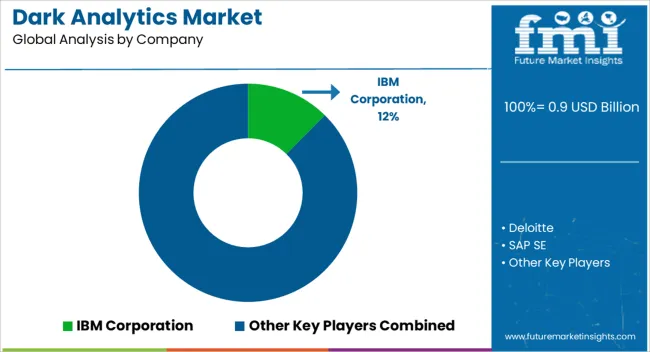
| Attribute | Details |
|---|---|
| Growth Rate | CAGR of 20.4% from 2025 to 2035 |
| Market Value in 2025 | USD 0.9 billion |
| Market Value in 2035 | USD 5.5 billion |
| Base Year for Estimates | 2025 |
| Historical Data | 2020 to 2025 |
| Forecast Period | 2025 to 2035 |
| Quantitative Units | Revenue in USD million and CAGR from 2025 to 2035 |
| Report Coverage | Revenue Forecast, Company Ranking, Competitive Landscape, Growth Factors, Trends, and Pricing Analysis |
| Segments Covered | Analytics type, Dark Data type, End User, Region |
| Regions Covered | North America; Latin America; Europe; Asia Pacific; Middle East and Africa |
| Key Countries Profiled | United States, Canada, Brazil, Mexico, Germany, United Kingdom, France, Spain, Italy, China, Japan, South Korea, GCC, South Africa, Israel |
| Key Companies Profiled | IBM Corporation; Deloitte; SAP SE; Teradata; Hewlett-Packard; EMC Corporation; VMware, Inc.; Microsoft Corporation |
The global dark analytics market is estimated to be valued at USD 0.9 billion in 2025.
The market size for the dark analytics market is projected to reach USD 5.5 billion by 2035.
The dark analytics market is expected to grow at a 20.4% CAGR between 2025 and 2035.
The key product types in dark analytics market are predictive, prescriptive, diagnostic and descriptive.
In terms of dark data type, business segment to command 42.8% share in the dark analytics market in 2025.






Full Research Suite comprises of:
Market outlook & trends analysis
Interviews & case studies
Strategic recommendations
Vendor profiles & capabilities analysis
5-year forecasts
8 regions and 60+ country-level data splits
Market segment data splits
12 months of continuous data updates
DELIVERED AS:
PDF EXCEL ONLINE
Dark Fiber Market Forecast and Outlook 2025 to 2035
Dark Tourism Market Forecast and Outlook 2025 to 2035
Dark Circle Treatments Market Size and Share Forecast Outlook 2025 to 2035
Dark Store Market Size and Share Forecast Outlook 2025 to 2035
Dark Rum Market Analysis - Size, Share, and Forecast Outlook 2025 to 2035
Glow in the Dark Cosmetics Market
Analytics Of Things Market Size and Share Forecast Outlook 2025 to 2035
Analytics as a Service (AaaS) Market - Growth & Forecast 2025 to 2035
Analytics Sandbox Market
Ad Analytics Market Growth - Trends & Forecast 2025 to 2035
HR Analytics Market
AI-Powered Analytics – Transforming Business Intelligence
NFT Analytics Tools Market Size and Share Forecast Outlook 2025 to 2035
App Analytics Market Trends – Growth & Industry Forecast 2023-2033
Text Analytics Market Size and Share Forecast Outlook 2025 to 2035
Drone Analytics Market Size and Share Forecast Outlook 2025 to 2035
Video Analytics Market Growth - Trends & Forecast 2025 to 2035
Cloud Analytics Market – Trends & Forecast through 2034
Visual Analytics Market Size and Share Forecast Outlook 2025 to 2035
Mobile Analytics Market Size and Share Forecast Outlook 2025 to 2035

Thank you!
You will receive an email from our Business Development Manager. Please be sure to check your SPAM/JUNK folder too.
Chat With
MaRIA